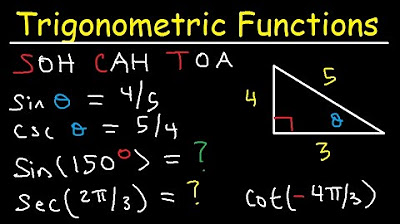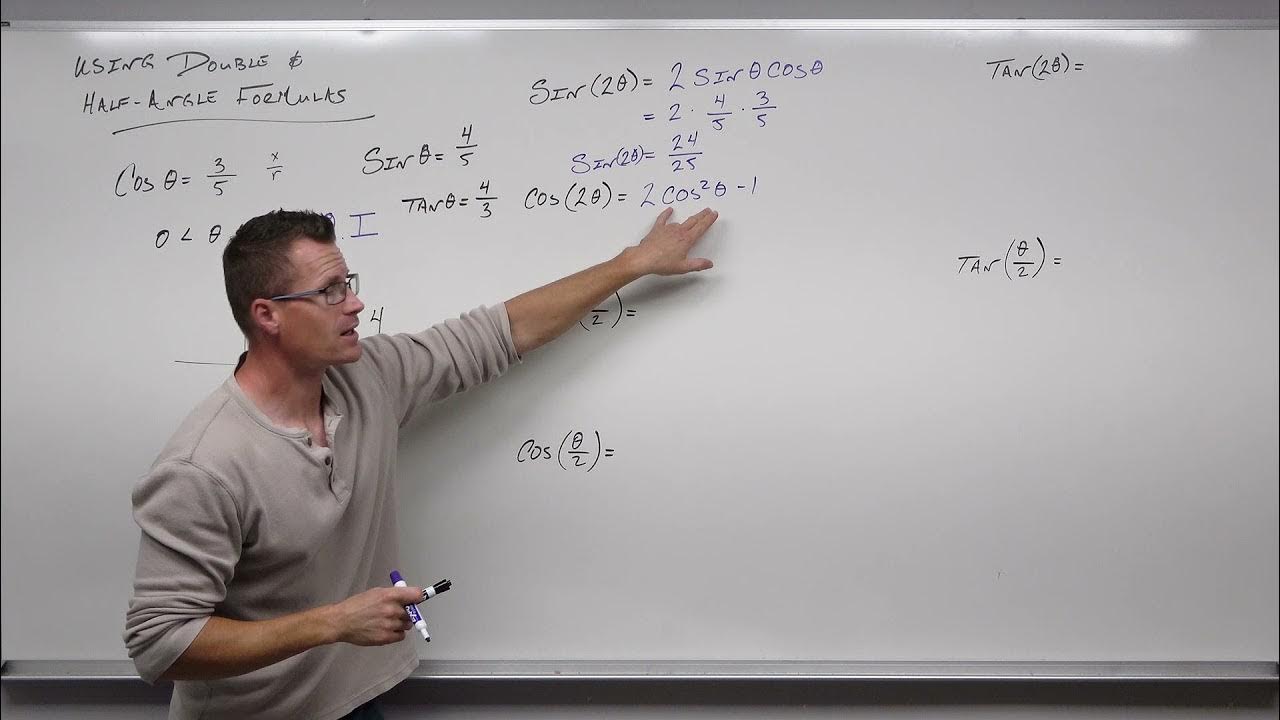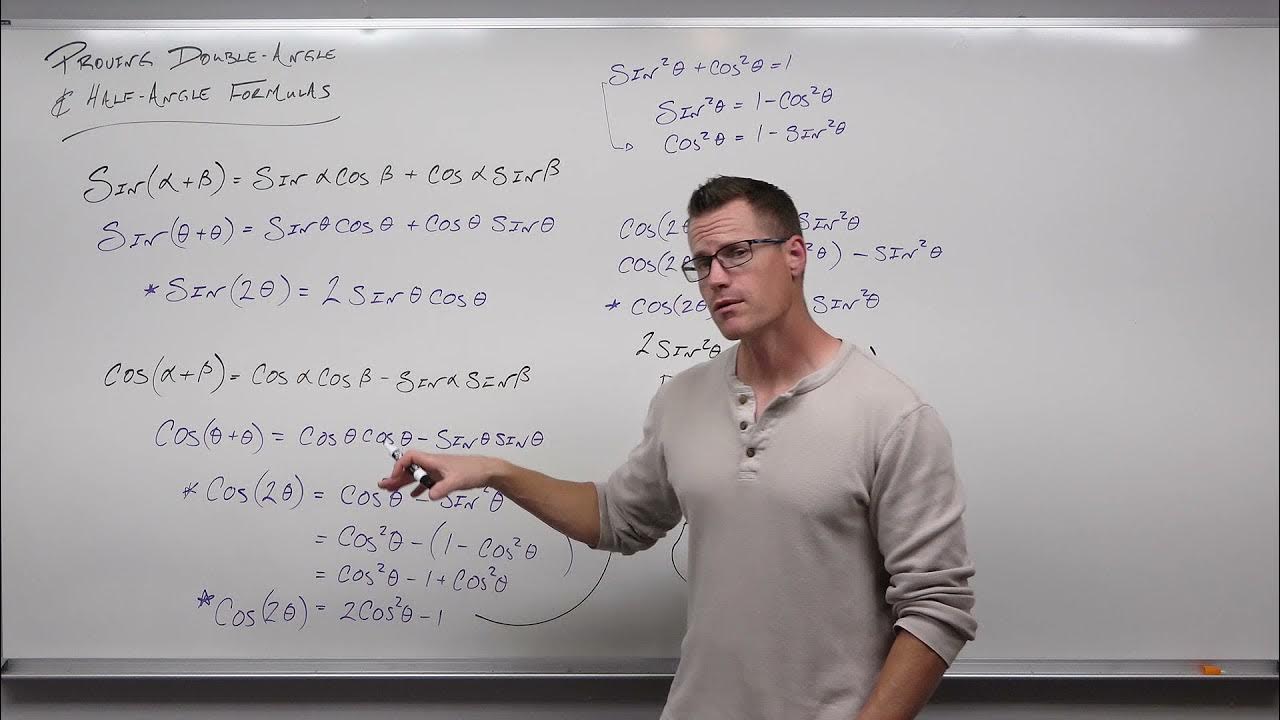Right Triangle Trigonometry and Half Angle Identities & Formulas
TLDRThis educational transcript delves into the calculation of trigonometric functions for right triangles, specifically focusing on half-angle formulas. It begins with a 3-4-5 triangle, explaining how to find sine and cosine of theta divided by two, using the Pythagorean theorem and rationalizing the results. The script then explores tangent calculation and validates the findings with alternative methods. Subsequently, it tackles a triangle in quadrant two with a tangent of 5/12, determining the half-angle sine, cosine, and tangent values. The explanation emphasizes the importance of considering the quadrant to ascertain the correct sign of the trigonometric functions, ultimately confirming the results with multiple approaches.
Takeaways
- 📐 The script discusses the process of finding the values of sine and cosine for half-angles in right triangles using the Pythagorean theorem and trigonometric identities.
- 🔍 The triangle given in the example has sides 3, 4, and 5, which is a Pythagorean triple, indicating it's a right triangle with angle theta.
- 📈 The sine of angle theta is calculated using the opposite side over the hypotenuse, which in this case is 4/5.
- 📉 The cosine of angle theta is found by taking the adjacent side over the hypotenuse, resulting in 3/5.
- 🔑 The half-angle formulas for sine and cosine are derived from the full-angle values and involve square roots and rationalization.
- 🌐 The script clarifies that the triangle is in quadrant one, where both sine and cosine are positive, which is crucial for determining the signs of the half-angle values.
- 📝 The tangent of angle theta is found by dividing sine by cosine, and in this example, it's shown that tangent(theta/2) is one-half.
- 🔢 The script provides an alternative method to find the sine of angle theta by using the full-angle identity sine = opposite/hypotenuse.
- 🤔 The second problem involves a triangle in quadrant two with a tangent of 5/12, requiring a different approach to find the half-angle values due to the negative cosine.
- 📌 The half-angle sine and cosine values for the second problem are calculated considering the signs and positions in the coordinate plane, resulting in positive values.
- 📚 The script concludes by confirming the tangent(theta/2) value using another trigonometric identity, demonstrating the consistency of the results.
Q & A
What is the given right triangle's side lengths?
-The side lengths of the given right triangle are 3, 4, and 5.
What is the angle theta in the context of the given triangle?
-Angle theta is the angle opposite the side of length 4 in the given 3-4-5 right triangle.
Why is the sine of theta divided by two considered positive?
-Since the triangle is in quadrant one and both x and y are positive, sine is positive.
How is cosine theta calculated in the given triangle?
-Cosine theta is calculated as the adjacent side divided by the hypotenuse, which is 3 divided by 5.
What is the formula for sine theta divided by two in the context of the script?
-The formula for sine theta divided by two is the square root of one minus cosine theta divided by two.
How is the value of sine theta divided by two simplified in the script?
-The value is simplified by multiplying the numerator and denominator by 5 and then rationalizing the denominator.
What is the value of cosine theta divided by two in the 3-4-5 triangle?
-The value of cosine theta divided by two is the square root of one minus three-fifths, which simplifies to 2 root 5 over 5.
How is tangent theta divided by two calculated in the script?
-Tangent theta divided by two is calculated as sine theta over two divided by cosine theta over two.
What is the tangent of theta divided by two in the 3-4-5 triangle?
-The tangent of theta divided by two is one-half, as sine theta over two and cosine theta over two simplify to cancel out the square root of 5 and the 5.
What is the significance of the tangent theta being 5 over 12 in the second problem?
-The tangent theta being 5 over 12 indicates the opposite side is 5 and the adjacent side is 12, forming a 5-12-13 triangle in quadrant 2.
How does the quadrant in which the triangle is located affect the signs of sine, cosine, and tangent?
-In quadrant 2, cosine is negative, while sine and tangent are positive, which affects the calculations of sine and cosine theta divided by two.
What is the value of sine theta divided by two for the 5-12-13 triangle?
-The value of sine theta divided by two for the 5-12-13 triangle is 5 root 26 over 26.
How is the value of cosine theta divided by two found for the 5-12-13 triangle?
-The value of cosine theta divided by two is found by taking the square root of one plus negative twelve over thirteen divided by two, which simplifies to root 26 over 26.
What is the tangent of theta divided by two for the 5-12-13 triangle?
-The tangent of theta divided by two for the 5-12-13 triangle is 5, as the sine and cosine values cancel out the square root of 26 and the 26.
Outlines
📐 Calculating Sine and Cosine of Theta/2 in a Right Triangle
The first paragraph discusses the process of finding the value of sine and cosine for an angle theta divided by two in a right triangle with sides 3, 4, and 5. The angle theta is identified, and the formula for sine theta over 2 is introduced as the positive square root of one minus cosine theta divided by two. The triangle's position in quadrant one confirms that sine must be positive. The cosine of theta is calculated as the adjacent side (3) over the hypotenuse (5), leading to the calculation of sine theta over 2. The process involves rationalizing the denominator and simplifying the fraction. The paragraph concludes with the tangent of theta divided by two, using the values of sine and cosine previously found, and confirming the result with an alternative method.
📐 Determining Half-Angle Trigonometric Values for a Triangle in Quadrant II
The second paragraph delves into a problem where tangent theta is given as 5 over 12, and theta is between pi over 2 and pi, placing the triangle in quadrant II. The triangle's sides are determined from the tangent ratio, resulting in a 5-12-13 triangle. The cosine of theta is calculated using the adjacent side (negative 12) over the hypotenuse (13). The sine of theta over 2 is then calculated, taking into account the signs and quadrant of the angle. The paragraph continues with the calculation of cosine theta over 2, again using the appropriate signs for quadrant II. The sine and cosine values for theta over 2 are confirmed to be positive, as theta over 2 would be in quadrant I. Finally, the tangent of theta divided by 2 is determined by simplifying the ratio of sine to cosine, resulting in a value of 5, which is then verified using an alternative trigonometric identity.
📐 Confirming Tangent Theta/2 Using Trigonometric Identities
The third paragraph is a continuation of the previous discussion, focusing on confirming the value of tangent theta divided by 2 using trigonometric identities. It reiterates the sine and cosine values for the triangle and applies them to the identity sine divided by (1 + cosine) to simplify and confirm the previously calculated tangent value. The process involves multiplying through by the hypotenuse to eliminate the complex fraction and arrive at the simplified value of 5 for tangent theta over 2, which confirms the correctness of the earlier result.
Mindmap
Keywords
💡Right Triangle
💡Angle Theta
💡Sine Theta
💡Cosine Theta
💡Tangent Theta
💡Half-Angle Formulas
💡Quadrant One
💡Rationalize
💡Pythagorean Triple
💡Trigonometric Identities
Highlights
Finding sine theta divided by two using the formula involving cosine theta.
Determining the triangle is in quadrant one based on the positivity of x and y.
Calculating cosine theta as the adjacent side divided by the hypotenuse.
Simplifying the expression for sine theta over two to its rationalized form.
Finding cosine theta divided by two using a similar approach to sine.
Using the half-angle identity to find tangent theta divided by two.
Alternative method to find tangent using the sine and cosine values.
Using the properties of a 3-4-5 triangle to find sine and cosine values.
Rationalizing the expression to find sine theta over two for the 3-4-5 triangle.
Determining the triangle's location in quadrant two for the tangent theta problem.
Calculating cosine theta for the 5-12-13 triangle in quadrant two.
Evaluating sine theta over two using the half-angle identity for a negative cosine.
Rationalizing the expression to find sine theta over two for the 5-12-13 triangle.
Finding cosine theta divided by two using the half-angle identity.
Determining the sign of sine and cosine for theta over two in quadrant one.
Calculating tangent theta divided by two using the simplified sine and cosine values.
Confirming the tangent theta divided by two value using an alternative equation.
Transcripts
Browse More Related Video

How To Find The Exact Value of the Five Remaining Trigonometric Functions

Trigonometric Functions of Any Angle - Unit Circle, Radians, Degrees, Coterminal & Reference Angles

How to Use the Double and Half Angle Formulas for Trigonometry (Precalculus - Trigonometry 28)

Inverse Trig Functions With Double Angle Formulas and Half Angle Identities - Trigonometry

Trig - 0.6 Trig Functions of Acute Angles

Proving the Double and Half Angle Formulas for Trigonometry (Precalculus - Trigonometry 27)
5.0 / 5 (0 votes)
Thanks for rating: